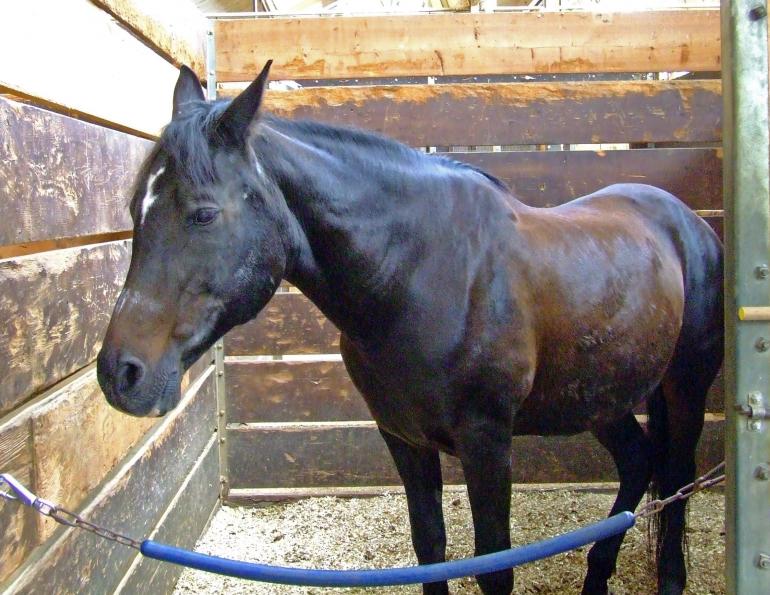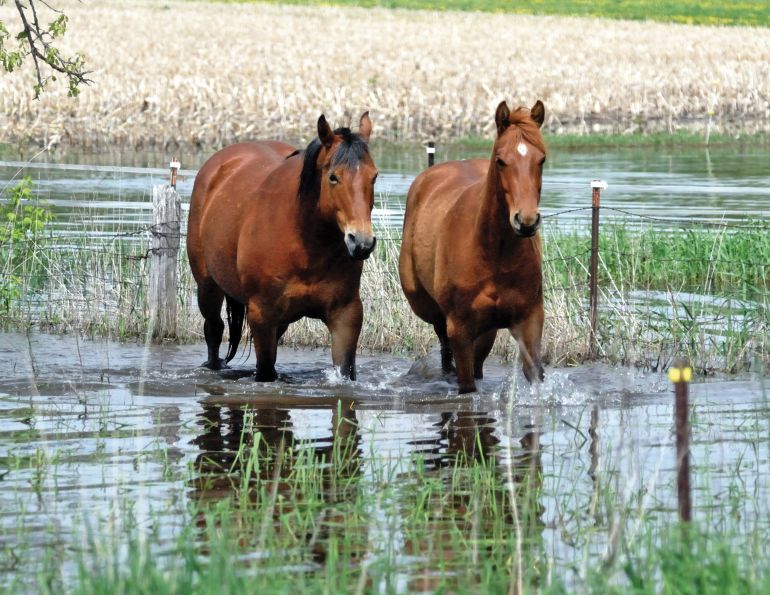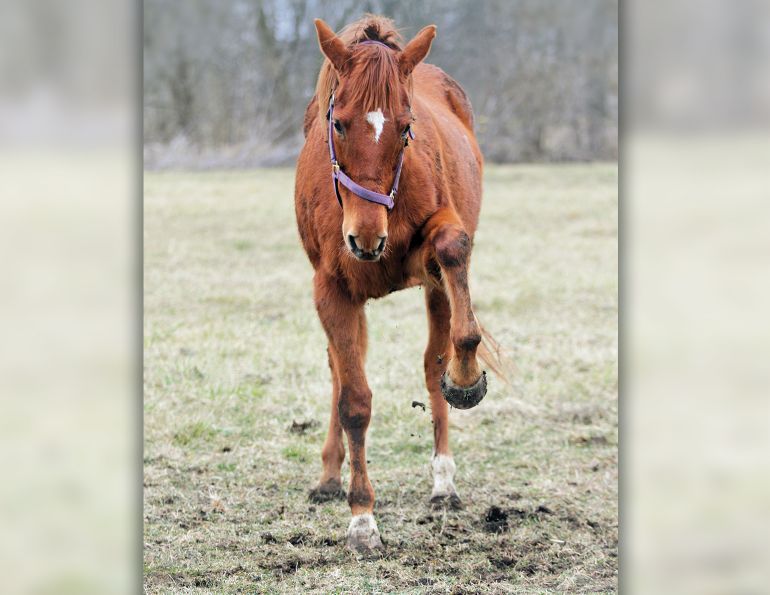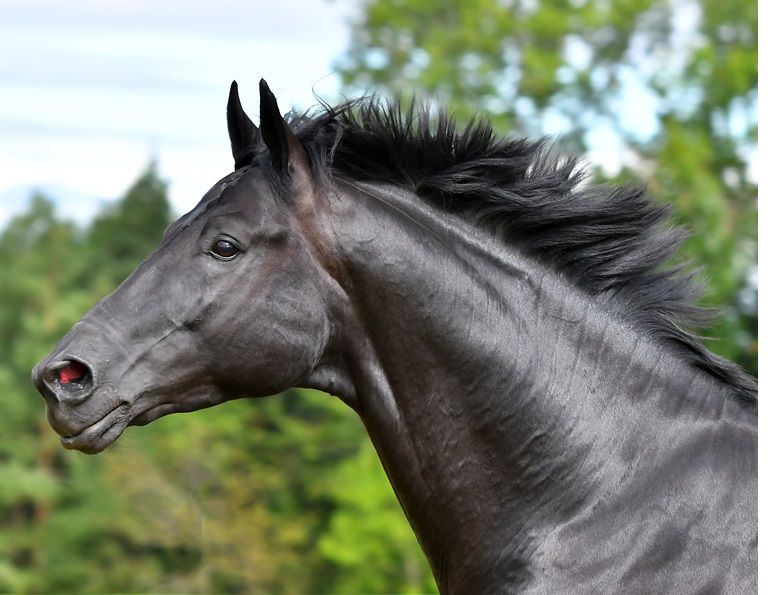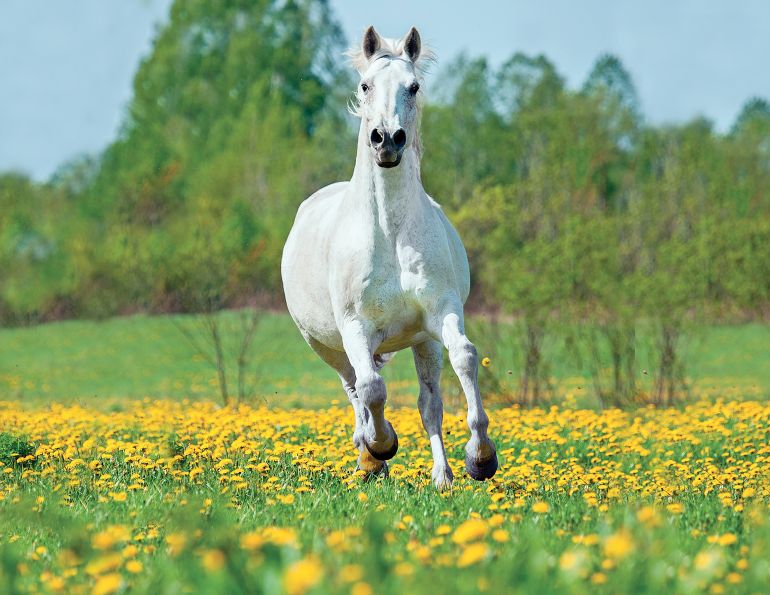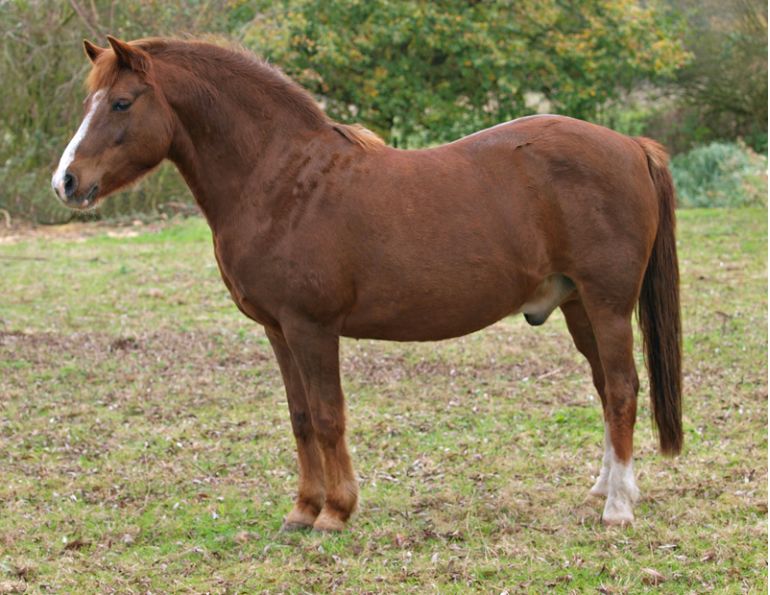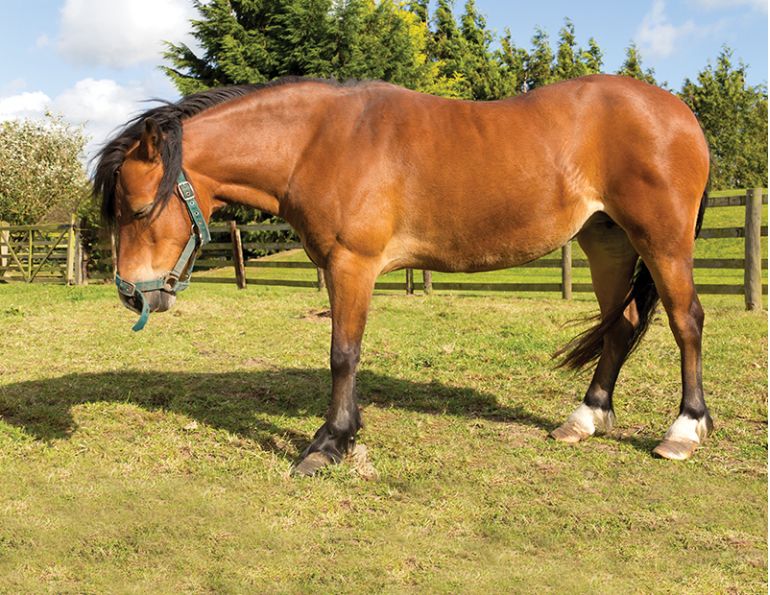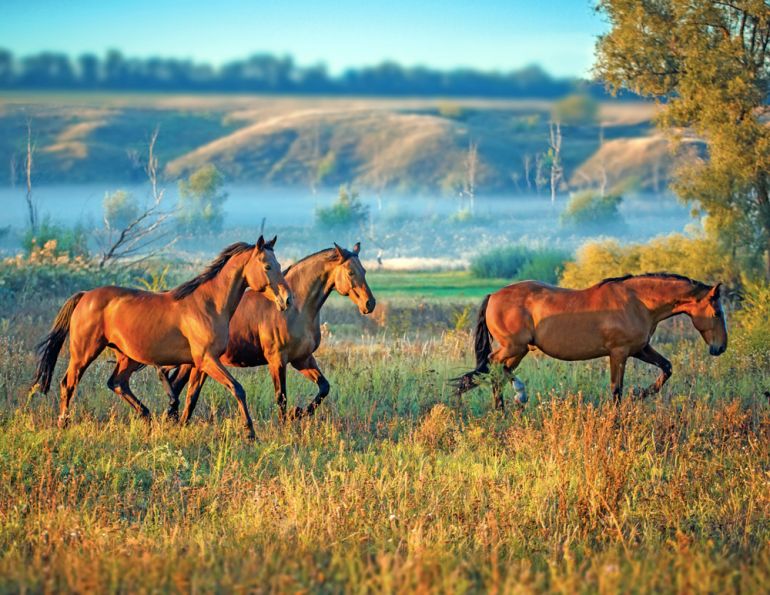Are allergen triggers hiding in your stable?
By Margaret Evans
At one time we owned a palomino mare who, in her senior years, suffered from heaves, an allergic-based disease that compromises breathing and is similar to how asthma affects humans. Zona had lived all her life in Brandon, Manitoba, and came to us on the west coast when she was in her early twenties. She had a persistent cough and her breathing was audible, especially when she was eating. While the more humid atmosphere of the coast helped, what was really beneficial was keeping her on pasture most of the time, away from the dust and spores in the barn. What also helped her condition was sourcing a better-quality grass mix hay and dampening it to eliminate dust.
Like humans, horses can be hypersensitive to a wide variety of allergen triggers including insect bites, pollens, dust and molds, chemicals in crop sprays, hay dust, stall bedding materials, wool (sometimes in saddle pad and blanket products), grooming sprays, shampoos, synthetic materials such as neoprene found in boots and pads, medications, supplements, and some ingredients in feed pellets.
Around the world, allergies in humans are on the rise, but whether there has been a corresponding rise in allergies in horses is still unclear.
“I don’t know if there’s been an increase in allergies,” says Wendy Pearson, assistant professor, equine physiology, University of Guelph. “I would suggest that we may be a little bit better at diagnosing and identifying what they are. I don’t know if they are more frequent, but we are just better at recognizing them.”
When a horse has an allergic reaction, its immune system perceives something from its environment as a threat and launches a response that is out of line with the normally benign condition. It leads to him becoming hypersensitive to the agent, or allergen, and his defenses are elevated so that, when next exposed, his reaction is quicker and stronger. The allergic reaction produces a chemical response that triggers the release of histamine, which can result in swellings or itching or other adverse physical conditions.
The two most common sites for an allergic reaction are the skin, which can suffer from hives (a cluster of swellings) and pruritis (intense itching), and the respiratory system when horses have a persistent nasal discharge and frequent coughing.
With winter approaching, horses may be spending more time in stalls and barns where dust gathers in hay rooms and the corners of stalls, and mold and mites can be found in dark corners of feed and tack rooms. If horses have been living out on pasture all summer, they may display a reaction to being inside once the windows are shut and the doors closed.
The most common causes for skin irritation are biting insects such as blackflies, horn flies, and stable flies, as well as the biting midge – the notorious “no-see-um” insect. Those bites result in sweet itch, also known as pruritis or seasonal recurrent dermatitis; the allergic response is a reaction to the proteins in the saliva of the midge. The intense itching can drive horses crazy, causing them to rub and scratch their skin, often developing a ratty tail, tangled mane, and inflamed skin patches on the belly, shoulders, or across the withers. All the rubbing and scratching can lead to secondary infections.
While biting midges are dormant in winter, the itch that a horse may have experienced in the fall from the midges’ biting behaviour can continue for a number of weeks. In severe cases, the horse may have incurred a skin infection, which itself causes itchiness. Even though the midges have gone, the horse will continue to scratch and rub himself, continuing the self-traumatizing behaviour until a cycle of relief can eliminate the irritation.
Hives may start as a few small, soft lumps on the horse’s neck, then quickly progress across his shoulders and sides. What triggered it may not only be insect bites but a variety of environmental allergens such as pollen, mold, and dust that the horse inhales, as well as contact allergens such as bedding, conditioners, and fly sprays.
But not all horses respond to allergen triggers in the same way, or even at all. A study conducted by researchers at the University of Edinburgh and published in 2015 in the journal, PLOS One, showed for the first time that, while all horses respond to allergens, their immune system can react in two different ways. One of the responses to the allergen is the release of certain substances secreted by cells in the immune system, known as cytokine lL-4. The other response, which is the release of another cytokine IFNy from the immune system, is to block different immune cells and negate the effects of the allergen. The animals in the study were Shetland ponies, and their responses to midge bites were similar to what happens in people with allergies.
The intent of the study was to better understand how the immune system responds to allergen triggers, and thus be able to prime the human immune system to respond to allergens in a way that does not influence reactions. Allergies are complicated interactions between genetic and environmental influences, and it is still a work in progress to understand why some individuals, and some horses, develop sensitivities and reactions to certain substances while others do not.
Respiratory allergies can occur in any season, and winter is no different. With hypersensitive horses, their airways may be further irritated by hay and bedding dust, and these animals will present with a persistent runny nose and possibly watery eyes. The more complex Recurrent Airway Obstruction condition, previously called heaves and now referred to as Equine Asthma Syndrome, presents with coughing, wheezing, and laboured breathing, which impacts the overall health of the horse.
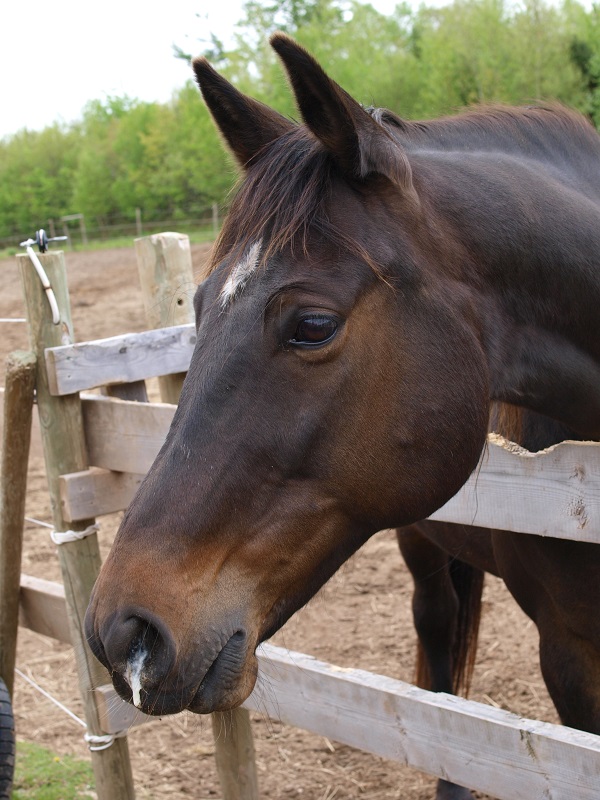
A persistent nasal discharge is often a telltale sign that the horse has a respiratory allergy. Photo: Pam MacKenzie
As with people, an allergic reaction in a horse can show within minutes or hours of exposure, and it may be from an unusual source. Years ago, a friend purchased a new saddle pad for her Thoroughbred eventer, but he became restless when being saddled. After mounting and warming up, the horse exploded with bucks and resistance. At first, she did not connect the saddle pad with her horse’s behaviour, but it soon became obvious that the saddle pad, made of wool, was the reason. The wool was itchy to the horse and an immediate source of irritation. And it may not have been the wool itself, but the chemicals and dyes in the product.
Being aware of the horse’s hypersensitivity to certain allergens is one half of the challenge; knowing how to help the horse avoid exposure is the other half. Treatment strategies always include allergen avoidance, topical therapies, and systemic medications such as antihistamines recommended by your veterinarian.
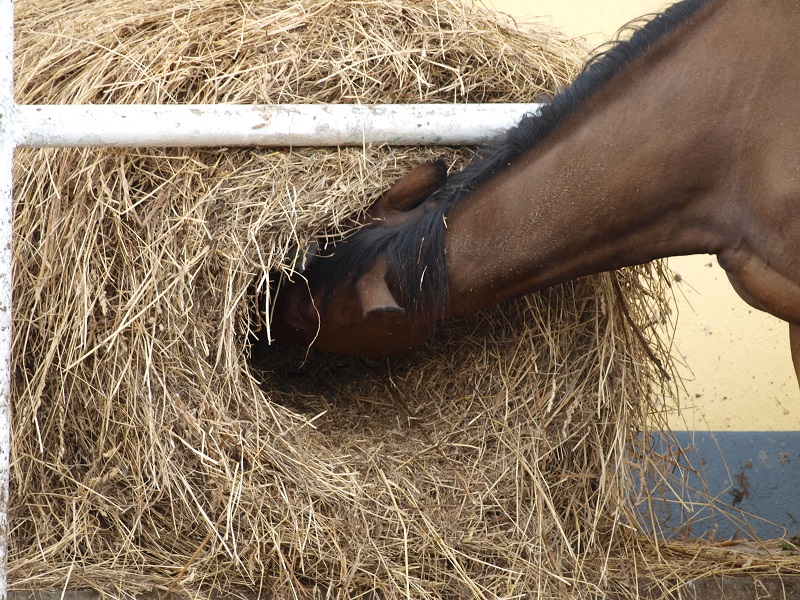
Horses can be hypersensitive to a variety of triggers including dust from hay and bedding. To reduce exposure to dust and keep horses from tunnelling into big round bales, open the bales and scatter the hay around. Photo: Canstock/Hanatipplova
Avoiding allergy triggers is the first place to start. With busy working and riding schedules it’s easy to overlook the darker recesses of barns, but a good regular cleaning of the walls and corners to remove buildup of dust, spider webs, and any floating material will help to minimize exposure. Feed should be kept in resealable plastic bins and purchased in smaller quantities so it can be replenished frequently to stay fresh, and so that the feed at the bottom of the bin doesn’t get moldy. Clean feed storage containers and buckets regularly. If mice are a problem, set traps and minimize their numbers; mice droppings add to dirt and dust on the floor. Keep the tack room warm to avoid dampness and prevent mold and mildew from forming on leather. Ensure all blankets are clean and dry on the inside where mice can’t get at them for nesting material, and mites cannot reach them to feed on skin cells.
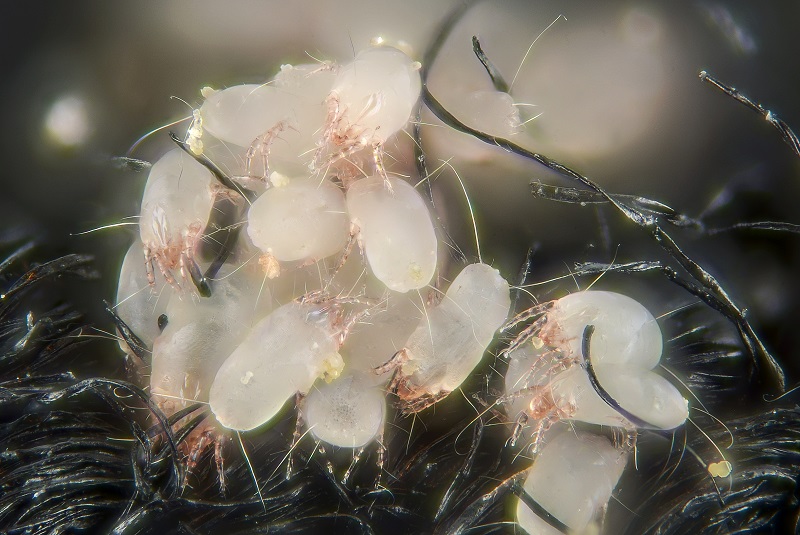
These are house dust mites, to which some horses are sensitive. A study in Australia found house dust mites in all horse blankets tested, and that horshypersensitive es reacted to the dust mite allergen on serum allergy testing. Photo: Wikimedia/Gilles San Martin
In a study done by the Department of Veterinary Science, University of Sydney, Australia, researchers tested 14 horse rugs and two saddle blankets for the presence of house dust mites. Dust samples from the rugs, blankets, and 16 control sites were collected with a vacuum cleaner with a modified attachment and filter. Dust mites were extracted with a floatation technique. Eight rugs and all control samples were positive for mites, and the study confirmed that house dust mites can indeed spread to horse blankets. The study also confirmed the dust mite allergen reactivity on serum allergy testing of hypersensitive horses. According to the report, it was the first study to document the presence of house dust mites in the equine environment. Further research was recommended to evaluate all the immunological responses, provocations, and avoidance measures to minimize exposure of allergic horses to the microscopic translucent mite that is barely 0.02 mm long.
It may not be totally clear why horses are sensitive to such tiny creatures, but avoidance and blanket management are essential to reduce risk. Frequent washings or cleanings are recommended, as well as isolating the blanket and keeping any rugs or blankets used on the hypersensitive horse away from blankets being used on other horses to avoid cross-contamination.
Helping a horse’s immune system cope with allergens spans not just avoidance and medications, but supplements too. In her article Spirulina, a Mighty Immune Modifier (Canadian Horse Journal, July 2015), Pearson focused on the properties of blue-green algae (BGA), also known as spirulina, found in fresh water, saltwater, tropical springs and, more recently, spirulina farming ponds.
Pearson says that the most well-known clinical effect of BGA is its ability to modify immune function.
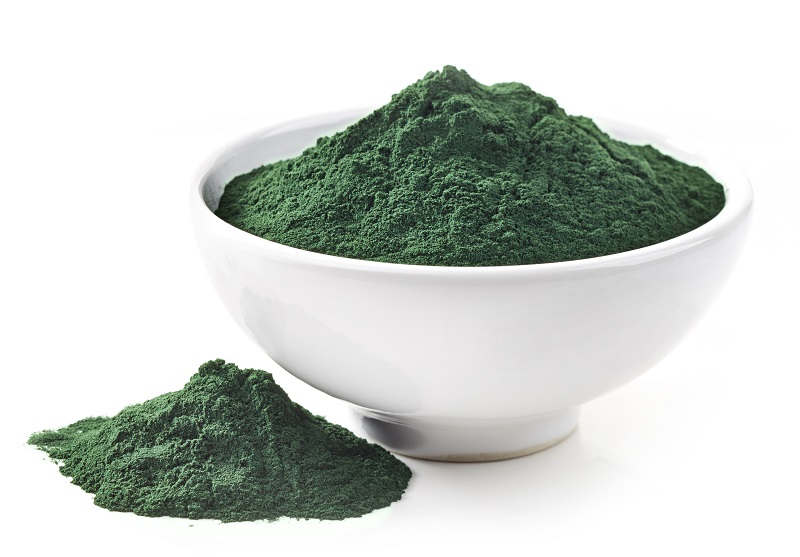
Spirulina, a type of blue-green algae (BGA), has the ability to calm overactive immune states such as allergies, and enhance immune function. Photo: ©Canstockphoto/Magone
“There is abundant evidence that overactive immune states (such as allergies) are calmed with BGA at doses as low as 10 mg/kg BW, both local and whole-body,” she writes. “And histamine – an important instigator of allergic symptoms – is strongly inhibited by BGA. However, in cases where an up-regulation of immune response is needed (such as during vaccination or exposure to a virus) BGA enhances immune function and protects animals against disease.”
Pearson believes that BGA is now more widespread in use.
“There is some really nice data on this in managing allergies [in people],” she says. “There isn’t anything on horses but there is some really nice, very good research data supporting the use of BGA in allergic conditions.”
At one time, Spirulina was classified as a plant because of its richness in plant pigments and its ability to photosynthesize, but a better understanding of its genetics and physiology has resulted in scientists moving it to the bacteria kingdom and placing it in the genus Spirulina. Three species within that genus are studied specifically for their nutritional and therapeutic values.
Many horses do far better living outside rather than living in a barn. In a paddock environment, horses will naturally adapt to conditions so long as they have adequate food, fresh unfrozen water, and shelter from wind and rain.
“This is my bias,” says Pearson. “Horses do better outside all around. They are more content, have far less diseases, and incidents of development of allergies in pasture-raised horses is almost zero. As soon as you put those animals in a barn, close all the doors and windows and put hay, bedding and other horses in there, it’s a breeding ground for allergens.

Horses that live outside are exposed to far fewer allergens. They are healthier in general, and will adapt to cold temperatures as long as they are provided with adequate shelter, sufficient food of good quality, and a plentiful supply of fresh, unfrozen water. Photo: Shutterstock/Natalya Rozhkova
“I bought a fairly high-end dressage horse. He had lived his whole life in a stall or a tiny paddock by himself. When he got to my farm, he lived out with 45 other horses and was never happier. He was very sound, very healthy. Horses are herd animals and thrive best with others.”
Depending on breed, horses will grow excellent coats in winter to cope with conditions. They are much better at adapting to the cold than we give them credit for.
“I am a big fan of haylage as long as it is properly prepared and cured,” says Pearson. “The haylage that we typically think about for dairy cows, baled at around 40 to 45 percent moisture, is not good for horses. You have to get haylage that is somewhere around 24 to 27 percent moisture. But if it is too low, you don’t have a good environment for the microbes to ferment the material. If you have well-prepared and well-preserved haylage, it is nutritionally exceptional. It is a very hygienic feed, so it’s low in dust and it has a much better nutritional profile compared to dry hay.
“Because we had a lot of horses last year and we had a loafing shed, the haylage could be stored under cover. Fifty horses would completely consume an 800-pound bale in 24 hours. Because they consume it quickly, it is safe feed. The problem with haylage comes when it sits outside, it doesn’t get completely consumed, gets exposed to wetness and sunshine, and then there is a botulism risk. Haylage has got a bit of a bad rap because of botulism, but mainly because it’s not managed properly. As long as the haylage is consumed completely within about 48 hours and not exposed to rain or direct sunlight, it is a very safe, nutritious feed.
“In certain paddocks on our farm and when we didn’t have access to the giant loafing sheds, we would feed the giant bales. We would open them up and throw the hay out and scatter it. That way, the horses aren’t standing in one spot trying to feed off a tight bale. There are ways to manage haylage or round bales safely. It’s the same hay you would be putting into square bales; it’s just the management of it.”
Regardless of time of year, horses can show signs that something in their diet might not agree with them. It may surface as hives, a swelling, hair loss, or diarrhea. A food allergy should always be discussed with a veterinarian who will provide guidance on protocols to isolate the offending substance which can then be eliminated. When it comes to subtle signs, it is really important to start recording when the signs first appeared, what the horse was fed both in the barn and in the pasture — including hay from a new hay supply source — and what treats might have been given. Dewormers should also be included, especially if they are new products not previously used. After that it becomes a process of elimination to see what may have triggered the reaction, or allergy, so that the appropriate steps can be taken.
Whether certain horse breeds are more susceptible to allergies is largely unknown, but a recent international study published in the Journal of Animal Breed Genetics and conducted by scientists in England, Belgium, Sweden, and the Netherlands looked at equine insect bite hypersensitivity (IBH) by biting midges in Icelandic horses and Exmoor ponies, and found an IBH predisposition in both breeds. It may be that a variety of horse breeds has a susceptibility to allergens, but because of the genetics of individual horses within the breed, they may or may not develop allergies.
Another genome-wide association study conducted in the Netherlands with 200 Shetland pony mares and 146 Icelandic horses identified several genomic regions associated with insect bite hypersensitivity.
In our modern world, with so many synthetic materials and various food sources entering the barn, it is not surprising that allergic reactions can occur with our equine friends. Sourcing the offending triggers and eliminating them just makes good horse sense.
Main Photo: Urticaria or hives is a skin reaction to allergies or other stressors. It often starts as a few small lumps on the horse’s neck, then progresses across the shoulders and sides. Photo: Sutterstock/Horse Crazy




